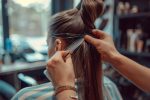The Woman’s Guide to Stronger, Healthier Hair

Hair loss can be a disheartening experience for anyone, but especially for women, for whom it often carries additional emotional and social stress. Recognizing and addressing hair loss early can significantly impact the effectiveness of your preventive measures and treatments. Let’s explore how to prevent female hair loss, ensuring your locks remain as healthy and vibrant as possible.
Hair loss in women can manifest in various forms, from thinning hair on the top of the head to noticeable bald patches. A blend of genetic, hormonal, and environmental factors often causes it. Understanding these can help in identifying the right preventive and treatment strategies.
Types of Female Hair Loss
Understanding the types of hair loss can guide women in identifying their specific condition and seeking appropriate treatment. Here are the most common types:
- Androgenetic Alopecia (Female Pattern Hair Loss) is women’s most common type of hair loss. It is characterized by thinning hair across the top of the head and widening of the part. It’s influenced by genetics and hormonal changes.
- Telogen Effluvium: A temporary condition often triggered by stress, pregnancy, severe illness, or significant weight loss. It results in diffuse hair shedding throughout the scalp.
- Alopecia Areata is an autoimmune disorder that causes patchy hair loss on the scalp and potentially other body parts. It can vary in severity, from small, discreet patches to total scalp hair loss (alopecia totalis) or hair over the entire body (alopecia universalis).
- Traction Alopecia is caused by constant pulling or tension on hair strands over a long period. It is often caused by certain hairstyles, such as tight braids, ponytails, or extensions.
- Cicatricial (Scarring) Alopecia involves permanently losing hair follicles and scalp scarring. It can be caused by various conditions, including infections and skin disorders.
Early Signs of Hair Loss to Watch For
Recognizing the early signs of hair loss is crucial for taking timely action. Here are key indicators:
- Increased Shedding: While it’s normal to lose 50-100 hairs a day, noticing more hairs on your pillow, in the shower drain, or on your hairbrush can be an early sign of hair loss.
- Thinning Hair: Gradual thinning on the top of the head is common among women. You might notice a wider part or less volume in your ponytail.
- Visible Scalp or Bald Spots: Any visible patches of the scalp or sudden bald spots can be an early warning of hair loss.
- Receding Hairline: Some women may experience a receding hairline, often starting at the temples.
- Changes in Hair Texture: Hair may become finer, not just thinner, affecting how it styles and holds shape.
Preventive Measures for Hair Loss
Preventing hair loss involves a holistic approach, focusing on lifestyle, diet, and hair care practices:
- Maintain a Nutrient-Rich Diet: Ensure your diet is rich in vitamins and minerals that support hair health. Iron, vitamin D, zinc, and protein are important for hair strength and growth.
- Gentle Hair Care: Avoid hairstyles that pull on the hair. Use a wide-toothed comb and avoid excessive brushing. Minimize heat styling and chemical treatments that can weaken hair.
- Scalp Health: Keep your scalp clean and healthy. Use gentle, pH-balanced shampoos, and consider products that promote hair growth or prevent hair loss.
- Stress Management: Chronic stress can contribute to hair loss. Incorporate stress-reduction techniques such as yoga, meditation, or regular exercise into your routine.
- Avoid Harmful Treatments: Avoid hair treatments that use harsh chemicals or heat, as they can contribute to hair breakage and loss.
- Regular Exercise: Regular physical activity can improve blood circulation, including to your scalp, promoting healthier hair growth.
- Adequate Sleep: Ensure you’re getting enough sleep. Lack of sleep can exacerbate stress and negatively impact overall health, including hair health.
- Hydration: Drinking plenty of water is essential for maintaining healthy hair, as hydration impacts your overall health and, by extension, your hair’s health.
- Supplements: If you need more nutrients from your diet, consider supplements. Biotin, vitamins D and E, zinc, and omega-3 fatty acids support hair health. Always consult with a healthcare provider before starting any new supplement regimen.
- Regular Check-ups: Sometimes, hair loss is a symptom of an underlying health issue. Regular medical check-ups can help identify any potential problems early.
By understanding the types of female hair loss, recognizing the early signs, and taking comprehensive preventive measures, women can better manage their hair health and mitigate the impact of hair loss.
Medical Treatments and Solutions
Medical treatments and solutions for female hair loss range from over-the-counter products to prescription medications, hormonal therapies, and surgical options. Treatment choice largely depends on the type of hair loss, its severity, and the underlying causes. Here’s a closer look at some of the most common medical treatments and solutions:
Minoxidil (Rogaine)
The most well-known over-the-counter treatment, Minoxidil, is applied directly to the scalp and can be used by both men and women. It’s particularly effective for treating androgenetic alopecia and telogen effluvium by promoting hair growth and preventing further hair loss. Results can take several months to become noticeable, and continuous use is required to maintain benefits.
Finasteride (Propecia)
Primarily used for male-pattern hair loss, finasteride is sometimes prescribed off-label for women experiencing androgenetic alopecia. It works by inhibiting the hormone DHT, which is thought to be a key factor in hair loss. Due to the risk of birth defects, its use in women is restricted to those who are not of childbearing potential.
Hair Transplant Surgery
Female hair transplant Turkey surgery involves moving hair follicles from one part of the scalp (the donor site) to the thinning or balding areas (the recipient site). It’s most effective for women with androgenetic alopecia who have distinct areas of thinning hair or baldness. There are two main techniques:
- Follicular Unit Transplantation (FUT): A strip of scalp with hair is removed from the back of the head and divided into individual follicular units to be transplanted.
- Follicular Unit Extraction (FUE): Individual hair follicles are directly extracted from the scalp and transplanted to the thinning areas.
- Platelet-Rich Plasma (PRP) Therapy: PRP therapy involves injecting a concentration of a patient’s platelets (derived from their blood) into the scalp.
Preventing female hair loss requires a comprehensive approach, including proper nutrition, hair care, and stress management. While it’s a common issue, many ways exist to address and mitigate its effects.
Ready to embrace the beard you’ve always dreamed of? Discover how Dr. Vivo Hair Clinic can transform your look and boost your confidence with our cutting-edge beard transplant treatments.









